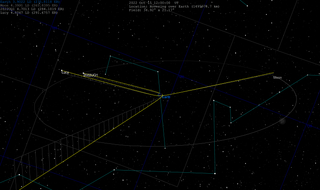Astronomy:2022 UQ1
2022 UQ1 was a minor planet provisional designation that was mistakenly given to the Lucy mission's Centaur upper stage booster during its Earth gravity assist flyby in October 2022.[1] The object passed about 9,100 km (5,700 mi) from the center of Earth (or an altitude of 2,700 km (1,700 mi) above the surface of Earth)[lower-alpha 1] during its closest approach on 16 October 2022.[2][3]
Because the object approached Earth from the direction of the Sun, it was not discovered until after its closest approach.[3] The object was discovered on 18 October 2022 by one of the Asteroid Terrestrial-impact Last Alert System (ATLAS) telescopes in Rio Hurtado, Chile , which reported it to the Minor Planet Center (MPC) as a near-Earth object candidate.[1] Three other observatories produced follow-up observations on the following day and confirmed the object was on a near-Earth orbit, prompting the MPC to announce the object as a new near-Earth object with the provisional designation 2022 UQ1 on 19 October 2022.[1] The object was later identified as the Lucy mission's Centaur upper stage booster by Bill Gray and Davide Farnocchia, resulting in the MPC deleting 2022 UQ1 from its database on 20 October 2022.[4][5][6]
Orbit
| Date | ESA nominal geocentric distance (AU) |
uncertainty region (1-sigma) |
|---|---|---|
| 2022-10-16 06:54 ± 00:17[lower-alpha 2] | 0.0000609 astronomical unit|AU (9,100 km)[lower-alpha 1] | ±0.0000002 AU (30 km)[lower-alpha 2] |
2022 UQ1 came to perihelion (closest approach to the Sun) on 27 July 2022 at a distance of 0.84 AU, between the orbits of Venus and Earth.[7] The Earth encounter in October reduced the period of its heliocentric orbit from 1 year to about 241 days and reduced its perihelion to 0.52 AU, placing it in between the orbits of Mercury and Venus.[8]
| Parameter | Epoch | Period (p) |
Aphelion (Q) |
Perihelion (q) |
Semi-major axis (a) |
Inclination (i) |
Eccentricity (e) |
|---|---|---|---|---|---|---|---|
| Units | (days) | AU | (°) | ||||
| 2022-Oct-01 | 365.72 | 1.1630 | 0.83870 | 1.0008 | 0.1271° | 0.16201 | |
| 2022-Nov-01 | 241.23 | 0.9977 | 0.51906 | 0.7584 | 1.4283° | 0.31557 | |
See also
Notes
- ↑ 1.0 1.1 Earth centerpoint approach distance of 9100 km – Earth radius of 6371 km = 2729 km from surface.
- ↑ 2.0 2.1 While the JPL Small-Body Database close approach table lists more inclusive (and thus larger) 3-sigma uncertainties, the European Space Agency close approach table lists more common 1-sigma uncertainties.
References
- ↑ 1.0 1.1 1.2 "MPEC 2022-U58 : 2022 UQ1". Minor Planet Electronic Circular. Minor Planet Center. 19 October 2022. https://minorplanetcenter.net/mpec/K22/K22U58.html. Retrieved 20 October 2022.
- ↑ 2.0 2.1 "ESA Close Approaches: 2022UQ1". European Space Agency. https://neo.ssa.esa.int/search-for-asteroids?tab=closeapp&des=2022UQ1. Retrieved 2021-10-19.
- ↑ 3.0 3.1 "JPL Small-Body Database Browser: (2022 UQ1)". Jet Propulsion Laboratory. https://ssd.jpl.nasa.gov/tools/sbdb_lookup.html#/?sstr=2022%20UQ1&view=OPC. Retrieved 2021-10-19.
- ↑ "MPEC 2022-U79 : Deletion of 2022 UQ1". Minor Planet Electronic Circular. Minor Planet Center. 20 October 2022. https://minorplanetcenter.net/mpec/K22/K22U79.html. Retrieved 20 October 2022.
- ↑ Gray, Bill J. (20 October 2022). ""Pseudo-MPEC" for Lucy Centaur". https://www.projectpluto.com/temp/lucy_cen.htm. Retrieved 20 October 2022.
- ↑ Gray, Bill J. (19 October 2022). "Re: 2022 UQ1 related to Lucy?". https://groups.io/g/mpml/message/38055. Retrieved 19 October 2022. ""It's definitely the Lucy Centaur.""
- ↑ Horizons output. "Perihelion on 2022-Jul-27". https://ssd.jpl.nasa.gov/horizons_batch.cgi?batch=1&COMMAND=%272022+UQ1%27&START_TIME=%272022-Jul-27%27&STOP_TIME=%272022-Jul-28%27&STEP_SIZE=%272%20hours%27&QUANTITIES=%2719%27.
- ↑ 8.0 8.1 Horizons output. "Osculating Orbital Elements for 2022 UQ1 at Oct + Nov 2022". https://ssd.jpl.nasa.gov/horizons_batch.cgi?batch=1&COMMAND=%272022+UQ1%27&TABLE_TYPE=%27ELEMENTS%27&START_TIME=%272022-10-01%27&STOP_TIME=%272022-11-01%27&STEP_SIZE=%271%20month%27&CENTER=%27@Sun%27&OUT_UNITS=%27AU-D%27.
External links
- Lucy rocket booster trajectory (Tony Dunn)
- Closest Asteroid Flyby in 2022 Was Really Space Junk From NASA Mission cnet.com, Oct 20, 2022
- Asteroid (NEO) 2022 UQ1
- 2022 UQ1 at NeoDyS-2, Near Earth Objects—Dynamic Site
- Ephemeris · Obs prediction · Orbital info · MOID · Proper elements · Obs info · Close · Physical info · NEOCC
- 2022 UQ1 at the JPL Small-Body Database
 |




